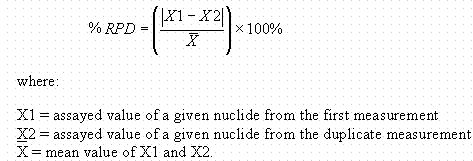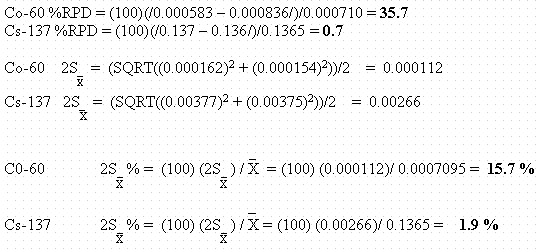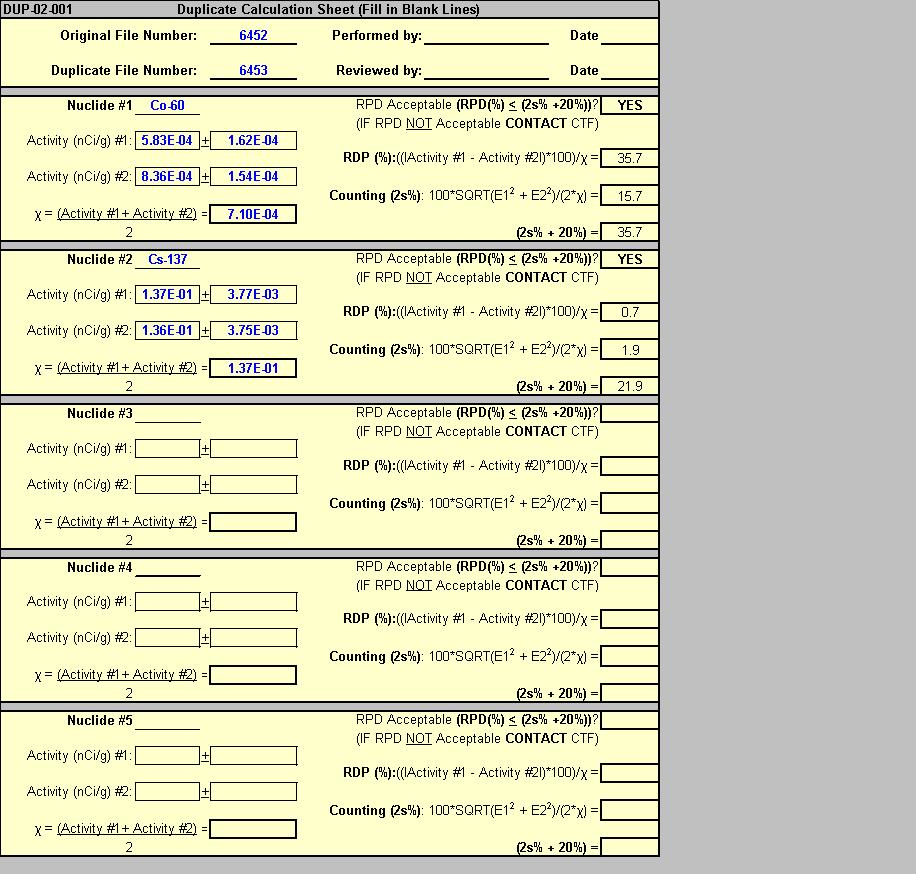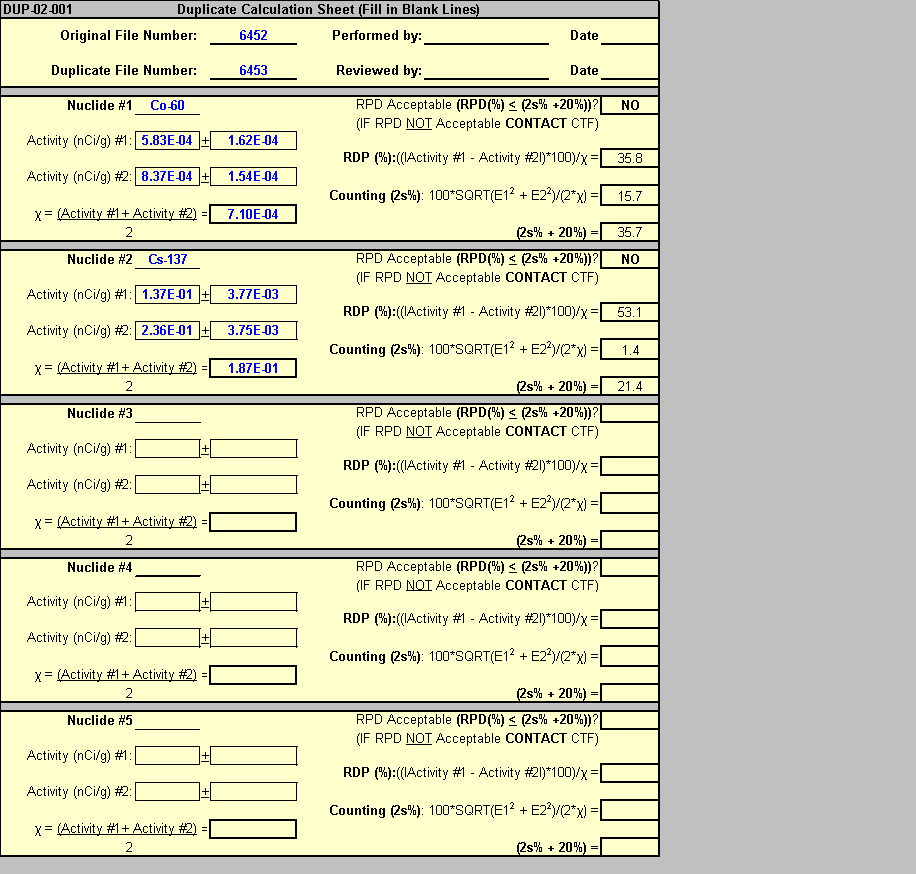
WSRC-TR-2002-00055
SRTC Spreadsheet to Determine
Relative Percent Difference (RPD) for
Duplicate Waste Assay Results and
to Perform the RPD Acceptance Test
Vito R. Casella
Westinghouse Savannah River Company
Aiken, SC 29808
This report was prepared as an account of work sponsored by an agency of the United States Government. Neither the United States Government nor any agency thereof, nor any of their employees, makes any warranty, express or implied, or assumes any legal liability or responsibility for the accuracy, completeness, or usefulness of any information, apparatus, product or process disclosed, or represents that its use would not infringe privately owned rights. Reference herein to any specific commercial product, process or service by trade name, trademark, manufacturer, or otherwise does not necessarily constitute or imply its endorsement, recommendation, or favoring by the United States Government or any agency thereof. The views and opinions of authors expressed herein do not necessarily state or reflect those of the United States Government or any agency thereof.
This report has been reproduced directly from the best available copy.
Available for sale to the public, in paper, from: U.S. Department of Commerce, National Technical Information Service, 5285 Port Royal Road, Springfield, VA 22161, phone: (800) 553-6847, fax: (703) 605-6900, email: orders@ntis.fedworld.gov online ordering: http://www.ntis.gov/support/index.html
Available electronically at http://www.osti.gov/bridge
Available for a processing fee to U.S. Department of Energy and its contractors, in paper, from: U.S. Department of Energy, Office of Scientific and Technical Information, P.O. Box 62, Oak Ridge, TN 37831-0062, phone: (865 ) 576-8401, fax: (865) 576-5728, email: reports@adonis.osti.gov
Keywords: Waste Assay, Acceptance Test, Duplicate Measurements, Spreadsheet
Abstract
Several quality control measures are used to ensure that waste assay data generated at the 773-A Solid Waste Assay Facility are in control. These measures include environmental background checks, calibration checks, scale checks with standard weights, and precision checks by performing duplicate analyses on every tenth routine analysis.
In order to verify that the precision of these duplicate analyses is within acceptable limits, the relative percent difference (RPD) of the duplicates is determined for each radionuclide measured. The RPD is equal to the positive difference of the two measurements (nanocuries/gram) for each radionuclide measured multiplied by 100 and divided by the average of the two measured values.
The following rules are used to determine if the RPD is acceptable. If the RPD is less than or equal to 20% plus the 2-sigma statistical counting error, then the RPD value is accepted. If any of the RPD's is greater than 20% plus the 2-sigma statistical counting error, then the RPD is not accepted and the Cognizant Technical Function must evaluate the potential effect on data quality and record a course of action on the duplicate calculation sheet.
This report documents the calculations and logic used for the Microsoft® Excel spreadsheet that is used at the 773-A Solid Waste Assay Facility for evaluating duplicate analyses, and validates that the spreadsheet is performing these functions correctly.
1. Introduction
Low-level and TRU waste are assayed in the 773-A Solid Waste Assay Facility with the 773-A Canberra Q2 Waste Assay System. It is a very low-level quantitative and qualitative gamma-ray, pulse-height-analysis system. The system uses three 20% efficient intrinsic Germanium detectors with 7.5-liter cryostats. A four-inch shield houses the sample turntable, which rotates at approximately 10 rpm, and an electronic load cell mounted on the turntable weighs the sample and displays the result. Each waste package to be assayed with this system is assigned a unique identification number by the computer. The summed spectra from three Germanium detectors are saved as permanent records and can be recalled to reproduce the assay results if necessary.
The Q2 is calibrated to assay waste in a 55-gallon drum geometry, while waste in other geometries may be assayed with the approval of the Cognizant Technical Function (CTF).
Several quality control measures have been implemented to ensure that the system is functioning properly. Standard weights are used at the beginning of each shift to verify that load cell is providing weights within prescribed limits. An environmental background check is run at the beginning of each shift, and the total background counts must be within the quality control chart limits or the CTF must be notified. A calibration check source is then counted to ensure that the peak energies, peak resolutions and peak activities at 59 keV, 662 keV and 1408 keV are also within quality control chart limits. This calibration check is run before and after each group of assays.
In order to verify that the precision of the analyses is within acceptable limits, every tenth routine analysis is run in duplicate and the relative percent difference (RPD) of the duplicates is determined for each radionuclide measured. The RPD is equal to the positive difference of the two measurements (nanocuries/gram) for each radionuclide measured multiplied by 100 and divided by the average of the two measured values. The RPD is considered to be acceptable if it is less than or equal to the sum of the overall analyses error, estimated to be 20%, and the 2-sigma statistical counting error. An Microsoft® Excel spreadsheet is used to calculate the RPD and determine if it is acceptable for a set of duplicate analyses.
2. Calculation of the %RPD and Rules for Acceptance
The RPD is calculated using the following formula:

The following rules, given in procedure L7.13-004, 1 are used to determine if the RPD is acceptable and describe the RPD review process.
a) If the RPD is less than or equal to 20% plus the 2-sigma statistical counting error, then ACCEPT the value by indicating "YES" on the "Duplicate Calculation Sheet".
b) If any of the RPD's is greater than 20% plus the 2-sigma statistical counting error, then DO NOT ACCEPT the value by indicating "NO" on the "Duplicate Calculation Sheet." The CTF will evaluate the potential effect on data quality and record a course of action on the affected instrument printouts (or Duplicate Calculation Sheet.)
c) When the RPD calculations are completed, then the CTF reviews and signs the assay result printouts (or Duplicate Calculation Sheet). The RPD calculations are kept in a binder at the Solid Waste Assay Facility.
3. Calculation of the 2-Sigma Statistical Counting Error for the Duplicate Mean Value

4. Determination if the %RPD is Acceptable
According to the rules of acceptance given above, the %RPD is acceptable if:

5. Duplicate Calculation Spreadsheet and Validation
An Excel spreadsheet has been developed to do the calculations described above and to determine if the %RPD calculated is acceptable. Examples of this spreadsheet are shown in Appendix 1 and Appendix 2. The assay technician or Cognizant Technical Function (CTF) inputs the duplicate file numbers, each nuclide measured, the activities in nCi/g for each nuclide, and the 2-sigma statistical counting error for each nuclide. For example, for spreadsheet labeled DUP-02-001 in Appendix 1, the following values are input.
Original File Number = 6452
Duplicate File Number = 6453
Nuclide #1 = Co-60
Activity (nCi/g) #1 = 0.000583 + 0.000162
Activity (nCi/g) #2 = 0.000836 + 0.000154
Nuclide #2 = Cs-137
Activity (nCi/g) #1 = 0.137 + 0.00377
Activity (nCi/g) #2 = 0.136 + 0.00375
The spreadsheet performs the calculations getting %RPDs for Co-60 and Cs-137 (35.7 and 0.7) and the 2-sigma statistical counting error for each nuclide (15.7 and 1.9). The spreadsheet determines that the %RPDs calculated are acceptable since they are less than or equal to the 2-sigma statistical counting error for the mean plus 20%. As a validation of the spreadsheet, these calculations are done below to show that they are correct.

The RPD is acceptable if it is less than the 2-sigma statistical counting error for the mean value percentage given above plus 20%.
Co-60 RPD = 35.7%; which is equal to (15.7% +20%) = 35.7% and is Acceptable
Cs-137 RPD = 0.7%; which is less than (1.9% +20%) = 21.9% and is Acceptable
If the second activities for Co-60 and Cs-137 listed for this example (DUP-02-001) were changed from 0.000836 and 0.136 to 0.000837 and 0.236, respectively, then the spreadsheet in Appendix 2 is obtained. For these nuclides, the RPD is now greater than the 2-sigma statistical counting error for the mean value percentage plus 20%, and the duplicates are not acceptable. As stated on the spreadsheet, if the RPD is not acceptable the CTF must be contacted.
This example validates that the spreadsheet is performing the calculations correctly. The spreadsheet is locked except for the cells for data entry, so that it cannot be changed, except by authorized personnel. After a spreadsheet is originated, the originator signs and dates the spreadsheet, and after it is reviewed and approved by the CTF. The CTF also signs and dates the spreadsheet on the designated lines. The spreadsheet is validated twice a year, at about 6-month intervals, and a validation schedule is kept with the spreadsheets. Spreadsheet validation consists of inputting data into the spreadsheet and verifying that calculations and logic are being performed correctly.
6. Conclusions
This report documents the calculations and logic used for the Microsoft® Excel spreadsheet that is used at the 773-A Solid Waste Assay Facility for duplicate analyses, and validates that the spreadsheet is performing these functions correctly.
7. References
Attachment 1. Example of Spreadsheet with Acceptable %RPD

Attachment 2. Example of Spreadsheet with Unacceptable %RPD
